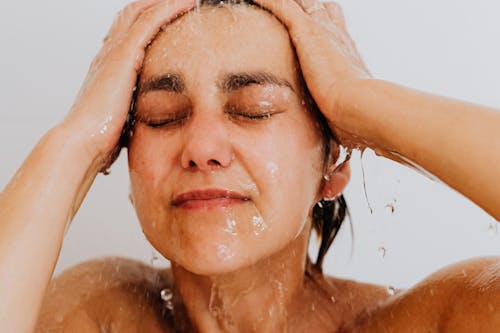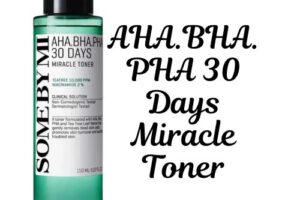How Your Daily Shower Routine Impacts facial Skin
Why Washing Your Face in the Shower May Be Harmful
High Water Pressure: Handle With Care
Your facial skin is incredibly delicate—nearly ten times thinner than the skin on your body. When you wash your face under the showerhead, the intense water pressure can batter that fragile barrier. Over time, this damage might lead to dryness, sagging, or even early wrinkles.
Another factor to consider is how pores behave in a steamy shower. The warmth opens them up, which may sound like a good thing, but it also leaves your skin more vulnerable to the relentless pounding of water. That’s like leaving your front door open during a storm!
Hot Water: A Recipe for Dryness
Let’s admit it: a hot shower feels heavenly, but it’s not doing your facial skin any favors. Typical shower temperatures—comfortably warm for your body—are way too harsh for your face. Hot water strips away the natural oils your skin relies on for hydration and protection.
Think of your skin barrier as a brick wall; hot water weakens the “mortar” holding everything together. This disruption can lead to dryness, redness, and irritation, leaving your face feeling tight and uncomfortable. Pro tip? Stick to lukewarm water (around 30–34°C) for washing your face, even if you love your steamy showers.
Bacteria and Residue: Sneaky Culprits
Your shower might be cleaner than most places, but it’s still a breeding ground for bacteria. The combination of humidity and warmth creates the perfect environment for microorganisms to thrive. When you wash your face in the shower, you risk exposing your skin to these unwanted guests.
Then there’s the issue of shampoo and body wash. These products are designed for hair and body—not for your delicate face. If they drip down your face, especially along the hairline and jawline, they can leave irritating residues, potentially leading to clogged pores or breakouts.
Potential Benefits of Shower Washing (When Done Correctly)
A Deeper Clean
When done right, washing your face in the shower can actually be beneficial. The steady flow of water helps rinse away makeup, dirt, and oil more effectively than a quick splash at the sink. Plus, there’s less chance of leaving behind residue that might clog your pores or irritate your skin.
The Steam Effect
Another advantage? The warm steam from your shower. This naturally opens up your pores, making it easier to remove dirt and impurities. It’s like getting a mini facial right in the comfort of your bathroom! Just be sure to follow up with cold water or a toner to close those pores back up afterward.
Precautions for Safe Shower Washing
To enjoy the benefits without harming your skin, keep these tips in mind:
Stick to Lukewarm Water: Hot water might feel amazing, but lukewarm water is your skin’s best friend.
Limit Water Exposure: Keep the water on your face for a short amount of time to avoid over-drying or irritation.
Go Easy on the Pressure: Opt for a low-pressure setting to avoid damaging your skin’s delicate barrier.
Proper Face Washing Techniques
Before Washing: Setting the Stage for Clean Skin
- Start With Clean Hands: Your hands carry dirt and bacteria that can transfer to your face. A quick wash ensures you’re starting fresh.
- Mind the Shower Stream: Washing directly under the stream might seem convenient, but it can be too harsh for your delicate facial skin. Instead, step aside and use your hands or a container to splash water on your face.
During Washing: Gentle but Thorough
- Pick the Right Cleanser: Choose a gentle, hydrating cleanser suitable for your skin type. Foaming cleansers are especially effective for removing dirt and oil without being too abrasive.
- Create a Luxurious Lather: Use a foaming net or your hands to build a soft, dense foam. This not only feels great but also minimizes the need for aggressive rubbing.
- Focus on Trouble Spots: Pay extra attention to areas prone to oil buildup, like your forehead, nose, and chin (the T-zone). Work the foam in light, circular motions to clean effectively without tugging at your skin.
Rinsing: A Delicate Finish
- Gentle Splashing: Use cupped hands to splash lukewarm water on your face. Avoid sticking your face under the shower spray or using excessive force.
- No Leftovers: Make sure all traces of the cleanser are rinsed away to prevent irritation or clogged pores.
Drying: The Final Step
- Pat, Don’t Rub: Use a clean, soft towel to gently pat your face dry. Rubbing can irritate the skin and even lead to microtears.
- Stay Hygienic: If you can, dedicate a separate towel for your face and wash it regularly to avoid bacteria buildup.
Shower Habits to Avoid for Healthy Facial Skin
1. Prolonged Exposure to Hot Water
Hot water feels great, but it’s not doing your skin any favors. Prolonged exposure can strip your skin of its natural oils, leaving it dry and vulnerable to irritation. Try to limit your shower time to 10 minutes or less, and keep the water temperature lukewarm (around 30–34°C) to maintain healthy, hydrated skin.
2. Shampoo and Body Wash Residue
While washing your body and hair, it’s easy for shampoo and body wash to run down your skin. These products are formulated for tougher skin, and their residues can irritate your face, especially along your jawline or hairline. Always try to avoid letting these products come into contact with your face, or rinse your face thoroughly to remove any potential irritants.
3. Storing Skincare in the Shower
It might be convenient to keep your skincare products in the bathroom, but heat and humidity from the shower can degrade the active ingredients in your creams, serums, and toners. To keep them working their best, store your skincare products in a cool, dry place away from direct steam or heat. This simple habit can help your skincare stay effective for longer.
Post-Wash Care
After you’ve gently cleansed your face, your skin is more receptive to hydration. Here’s how to maximize the benefits:
1. Apply a Hydrating Toner or Serum
Right after washing, your skin is in its most absorbent state, so it’s the perfect time to apply a hydrating toner or serum. These products help to balance the skin’s pH and lock in moisture. Choose one with ingredients like glycerin, hyaluronic acid, or aloe vera to keep your skin feeling fresh and plump.
2. Follow Up with a Moisturizer
To seal in the hydration and restore the skin barrier, finish with a nourishing moisturizer. This helps to prevent moisture loss and ensures your skin stays soft and protected throughout the day or night. For an extra boost, consider a moisturizer with ceramides, which help to strengthen the skin’s natural defenses.














Post Comment